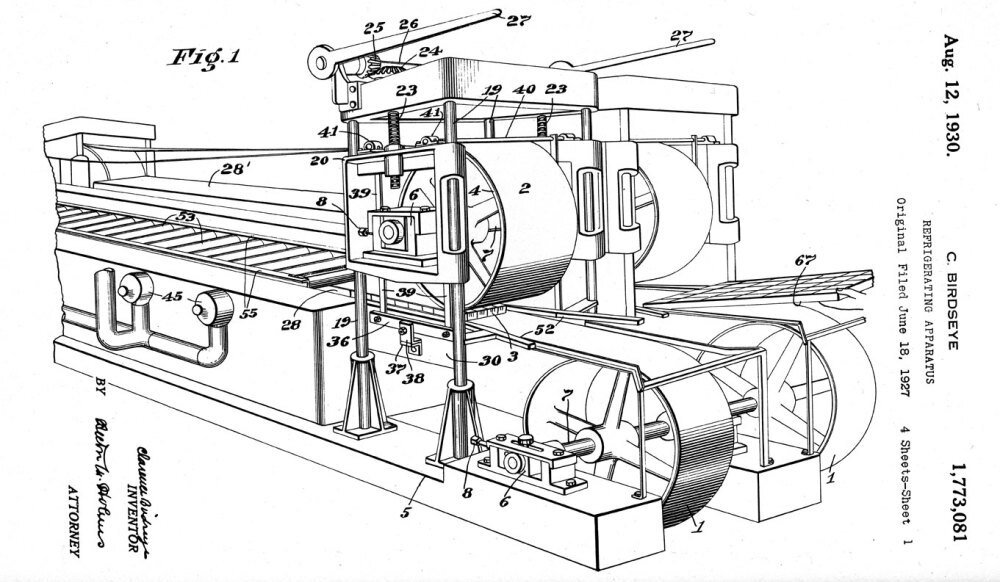“The fish stick is the bane of school children who consider it to be a bland, over cooked, breaded – crusted, cardboard tasting, fish-less effort of lunchrooms and mothers to deceive them into consuming more protein.” In the 1920s, entrepreneur Clarence Birdseye developed a novel freezing technique. Food was placed between metal plates which froze the food quickly and prevented large ice crystals from forming. When used on fish, the method created large blocks of intermingled fillets. When pried apart, the fillets tore into “mangled and unappetizing chunks,” Clarence Birdseye’s Frozen Food Machine Josephson wrote, the fishing industry tried selling the blocks whole as “fish bricks.” The fish blocks were packaged like blocks of ice
Topics:
run75441 considers the following as important: Journalism, US EConomics
This could be interesting, too:
NewDealdemocrat writes JOLTS revisions from Yesterday’s Report
Bill Haskell writes The North American Automobile Industry Waits for Trump and the Gov. to Act
Bill Haskell writes Families Struggle Paying for Child Care While Working
Joel Eissenberg writes Time for Senate Dems to stand up against Trump/Musk
“The fish stick is the bane of school children who consider it to be a bland, over cooked, breaded – crusted, cardboard tasting, fish-less effort of lunchrooms and mothers to deceive them into consuming more protein.”
In the 1920s, entrepreneur Clarence Birdseye developed a novel freezing technique. Food was placed between metal plates which froze the food quickly and prevented large ice crystals from forming. When used on fish, the method created large blocks of intermingled fillets. When pried apart, the fillets tore into “mangled and unappetizing chunks,”
Clarence Birdseye’s Frozen Food Machine

Josephson wrote, the fishing industry tried selling the blocks whole as “fish bricks.” The fish blocks were packaged like blocks of ice cream. The idea was a home cook could chop off as much fish as a housewife wanted to feed the family that day. The supermarkets were not successful in selling unwieldy and unattractive bricks. Many of the stores also lacked adequate freezer space to display them.
The problem with early freezers chilling meat and vegetables slowly, caused the formation of large ice crystals turning food mushy when defrosted was resolved. The frozen fish went from having a terrible reputation to a product having an improved reputation.
The problem still remained of improving the fish block image and getting Ms. Housewife to take them home, cut off a portion of the blocks, cook the portion, and feed her family at the dinner table. The fish was still packaged in unwieldy, unattractive bricks.
Clarence Birdseye had developed the novel freezing technique which placed food between cold metal plates. The technique froze the food quickly not allowing the large ice crystals to form. What remained was how to market the fish bricks in an attractive manner.
Portioning the blocks of fish and presentation was solved when the bricks were cut into standardized sticks. Over the years, the process has remained unchanged. In preparation for proportioning, the frozen fish blocks are X-rayed to ensure they’re bone-free and then cut by band saws into slices.
The resulting fish “fingers” were dumped into a batter of egg, flour, salt, spices, and breaded. The end process involved a dunking of the fingers into hot oil to set the coating. The process takes ~ 20 minutes during which the fish remains frozen even while dunked in the deep fryer.
In my home and if we did not have the Smelt my father netted or lake perch, we were probably eating Birdseye or Mrs. Paul’s fish fingers like much of the rest of America.
The commercialization of fish fingers can be traced to 1953 when the American company Gorton-Pew Fisheries, now known as Gorton’s, was the first company to introduce a frozen ready-to-cook fish finger. Gorton’s Fish Sticks won the Parents magazine Seal of Approval in 1956.
Thirteen companies produced 3.4 million kilograms of fish sticks in 1953. A year later, 4 million kilograms were produced by another 55 companies. The surge in popularity was partly due to a marketing push that stressed the convenience of the new food product:
“no bones, no waste, no smell, no fuss,”
as one Birds Eye advertisement proclaimed.
The appeal of fish sticks is commercially enhanced as are many processed foods. It is not fresh caught filleted fish. The sticks contain fish, but only fish with the mildest flavor or fish having been processed to resemble chicken tenders.
The battered disguise of fish bits is needed in the US as fish tends to be a second-tier food with beef of pork being preferred.
“We’ve mostly considered the eating of fish to be beneath our aspirations,”
wrote the chef and author Barton Seaver in American Seafood.
The eating of fish is associated with sacrifice and penance. It is a food to eat when beef was unaffordable. If you were Catholic, it was a practice to eat fish on Fridays or other days in place of red meat.
A survey reveals one in five young adults believes the sticks are actually the fingers of fish.
They still eat them happily.
Fish Sticks Make No Sense, The Atlantic
Clarence Birdseye And His Fantastic Frozen Food Machine, NPR
